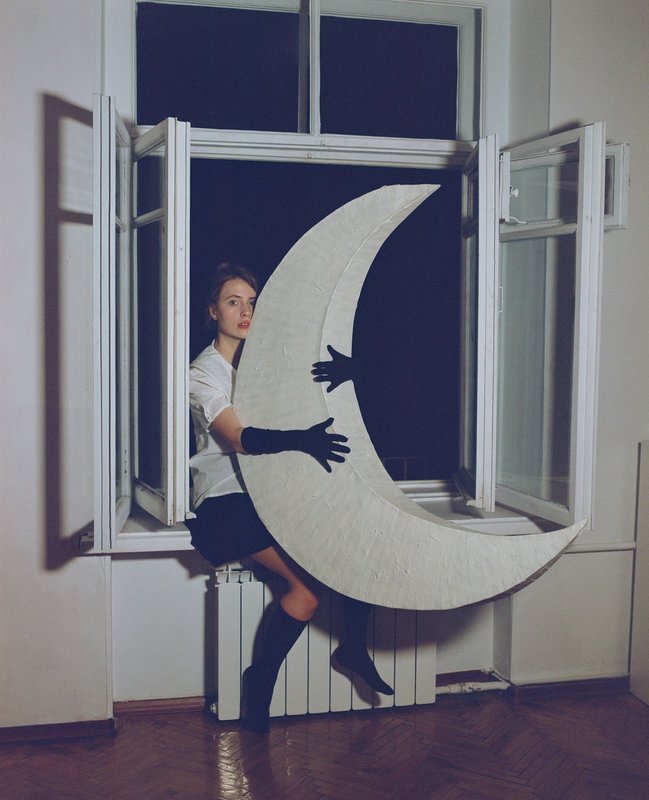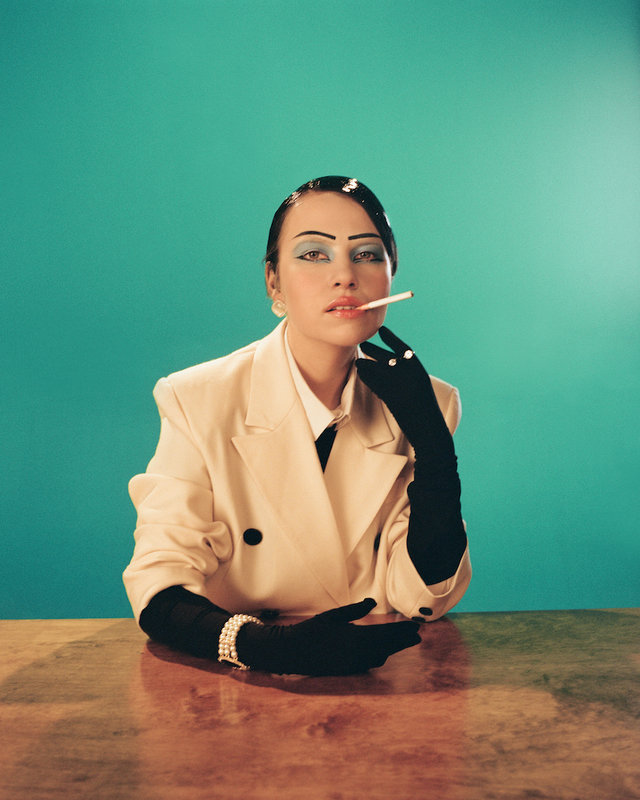
“There was a moment where my body was like, dude! I need to sing. I was tired of standing in front of a table. On a physical level, my body was like, I want to move more,” said Kate Shilonosova, the Moscow-based music and visual arts multi-hyphenate, better known as Kate NV. When I spoke with her by phone from her home in May, Shilonosova was reflecting on the sequence of events that led to the creation of her remarkable new album “Room for the Moon”, released on June 12 through storied New York label Rvng Intl.
Ostensibly, Shilonosova’s journey towards “Room For The Moon” began in the wake of the release of her second album “для FOR” in 2018. A suite of ten fantastically playful, plastique-synthetic ambient compositions that tapped into the texturally rich traditions of Japanese Kankyō Ongaku and American composer Jon Hassell’s Fourth World Music conceptualisations, “для FOR” was sonic cartography - a rescoring of the streets of Moscow in elasto-surrealistic tones.
After releasing “для FOR”, Shilonosova bundled up her studio equipment and spent a year and a half touring an improvised electronic music performance in the spirit of the album. She described the experience as like being at the controls of a starship hurtling through space at hyperspeed. “You’re trying to be in control, but you have to let the music happen the way it wants to, but that requires a lot of concentration,” she explained. The performance required her to be still, standing or slightly bending over the equipment, and at a certain point, it became physically painful. “Maybe the peak of this feeling was my experience with the Buchla synthesizer,” Shilonosova said.

“There was a moment in my life when I didn’t want to sing much, and now I want to sing more. I think Buchla helped me, and that moment shaped me. I think she is she; she showed me I was searching for something else in that moment.“
In 2019, Shilonosova booked a week and a half of recording time at EMS (Elektronmusikstudion) in Stockholm, the Swedish centre for electroacoustic music and sound-art. EMS is famed for its collection of synthesizers, and Shilonosova went there specifically to work with the vintage Buchla 200 series modular synthesizer. “I had a very interesting relationship with this synthesiser,” she said. “The first few days, I cried because I couldn't figure out how to connect with this thing. I understood how it works, but I didn't understand how to work with this knowledge. Then I figured out how to make it do something, but there was a point where I couldn't work out how to get it to do what I wanted.”
Suddenly, the problem became lucidly clear: she was trying to force a synthesizer to function like a human being. “At that point, I realised I missed the human in my music,” Shilonosova said. “The most human thing you can do in your music is use your voice.” That realisation was the moment she needed to return to songcraft in its traditional sense and revisit the melody-led synth-pop and boogie sound she’d mapped out on her debut album “Binasu” in 2016. “There was a moment in my life when I didn't want to sing much, and now I want to sing more,” Shilonosova said. I think Buchla helped me, and that moment shaped me. I think she is she; she showed me I was searching for something else in that moment. I really appreciated that week in Stockholm; it was insane. I made so many cool recordings, and she helped me realise I want to play in a band, I want to play these songs as a band, I want to sing and dance, I don't even want to play an instrument.”
“My mum is a huge fan of Soviet fairy-tales from that era. Those movies were always about beautiful music and beautiful, insane imaginary worlds. She was so careful and picky regarding what came to my eyes and ears.“
With that realisation as a moment of inspiration, Shilonosova gathered up several of her longstanding musical collaborators and fashioned a shimmering, escapist cycle of synth-pop and post-punk songs sung sweetly in Russian, French and English. In terms of the palette she used while creating them, Shilonosova dug into two specific memory zones and musical geographies, hypnagogic locales that pertained to her childhood and mid-twenties. While as I wrote earlier, “Room For The Moon” ostensibly began in the wake of “для FOR”, you could make the argument that Shilonosova was always destined to make an album like this. You might even say it was written in the stars.
“I was born in the late '80s, and I grew up in the ‘90s watching movies from the ‘70s and ‘80s,” she said. “My mum is a huge fan of Soviet fairy-tales from that era. Those movies were always about beautiful music and beautiful, insane imaginary worlds. She was so careful and picky regarding what came to my eyes and ears. The old books she gave me, the old illustrations, the music, the movies that I listened to as a kid.”
In 2012, Shilonosova started DJing with a group of her friends. In the process, she was introduced to the sparkle of late ‘70s/early '80s Japanese technopop and city pop and instantly felt a kinship with the sounds Haruomi Hosono, Ryuichi Sakamoto and their peers had dreamed up. Two years later, she had the opportunity to deepen this kinship while attending the first term of the 2014 Red Bull Music Academy in Tokyo. “It was like I had come home,” she said. “The old books my mum gave me, the old illustrations, the music, the movies that I listened to as a kid - it had the same atmosphere as Japanese music from the 80s. I can really relate to this type of music because I think it speaks to a person’s inner child. For me, it creates another world, but it is a world I grew up with.”

Shilonosova was born in Kazan, the capital and largest city of the Russian Republic of Tatarstan. The republic’s traditional music is based around the pentatonic scale, and while Tatar music is faster than Japanese music, there are commonalities. “When I was a kid, I listened to this music a lot. I was born there, and I went to music school and studied Tatarsan music,” she explained. “I'm pretty sure it had a huge impact on me as a listener. You get all this information as a kid; you’re like a sponge. When you’re older, you somehow rework it. I think my connection with the pentatonic scale is part of while I feel at home with Japanese music. It’s the weird combination of everything I love: a level of ridiculousness, fun and freedom, and not being afraid to look foolish in the decisions people make while they make music. It is the greatest combo.”
Across “Room For The Moon”, and the striking music videos that accompany it, these two worlds (which are one world) find balance and alignment by recasting the children’s fairy tales and innocently naive melodies of ‘70s/’80s Russia and Japan into a 21st-century updating of the urban and the folkloric. A trans-pacific city-pop/post-punk aesthetic linked by Cluedo-style secret passages between countries and cultures. From the angular, neo-psychedelia drift of “Marafon 15” to the shuffling, moonlight torch song laments of “Sayonara”, it’s the sort of record that burns itself into your memory and your dreams.
When we spoke, Shilonosova was - like many around the world - self-isolating in response to the COVID-19 pandemic, and had been using the time alone to reflect, reassess and take stock. I asked her what it meant to release music in these times, and she explained that while her initial impulse was to postpone the album, in the end, the hope that hearing “Room For The Moon” might help people through hard times won out.
“It is almost impossible to compete with the insane level of news we get every day, and I am not trying, but if I can help by releasing during these crazy times, that would be the best present for me,” Shilonosova said. “Also, mentally, I cannot postpone it any longer. I've been holding these songs to myself for too long. It is just impossible. I have to accept reality the way it is right now, just like lots of other people. There is nothing we can do; I am doing my best. The best you can is good enough.” Pausing for a moment, she broke into a laugh before continuing. “Oh my god, I literally just quoted Radiohead; crazy.”
'Room For The Moon" is out now in digital format through RVNG Intl. LP and CD versions will be available later in the year (order here).
Photography credits - First: Talib Shillaev. Second: Richard Johnathan Miles. Third: Talib Shillaev. Supplied by RVNG Intl.


